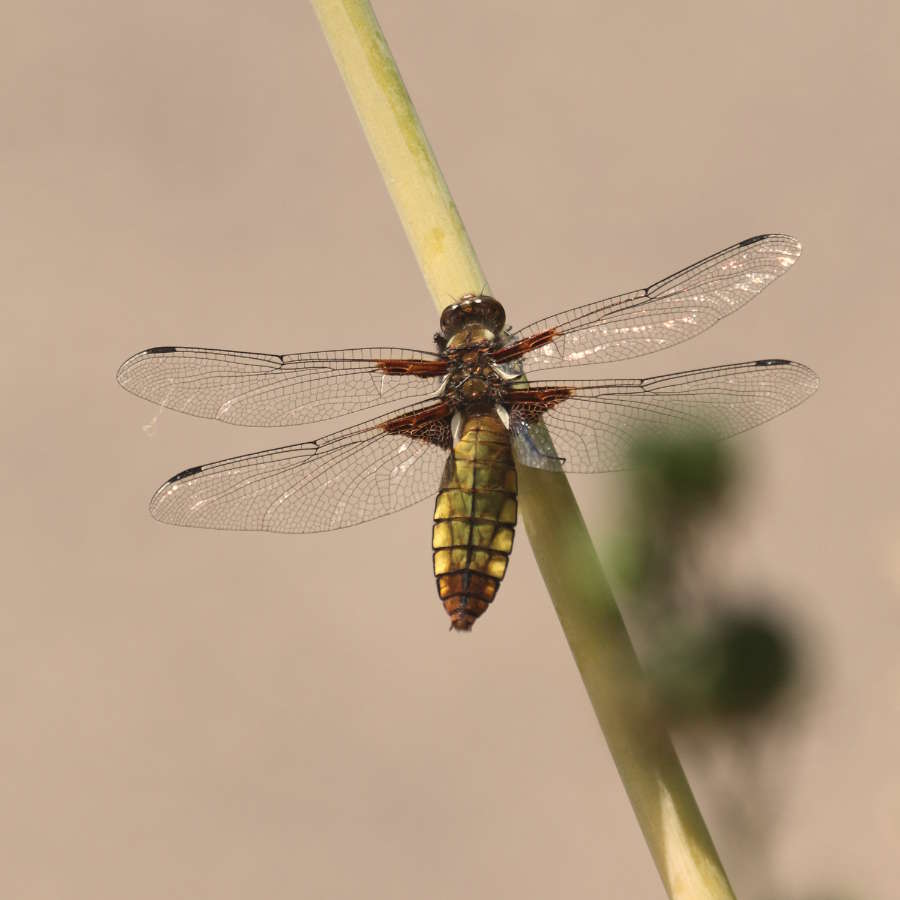How to identify
The broad, flattened body of the Broad-bodied chaser is distinctive and makes this dragonfly appear 'fat'. The male has a powder-blue body with yellow spots along the sides and a dark thorax; the female is greeny-brown. There are several medium-sized, pale blue dragonflies that can be confused. This species can be distinguished by the combination of its broad, blue body and chocolate-brown eyes.https://www.devonwildlifetrust.org/wildlife-explorer/invertebrates/dragonflies/broad-bodied-chaser
British Dragonflies Very broad, ‘fat’ dragonfly. Male: Blue abdomen with yellow spots on the side. Female and immature males: Golden-brown abdomen with paler spots on the sides.
https://british-dragonflies.org.uk/species/broad-bodied-chaser/

Female Broad-bodied Chaser in our garden in Chulmleigh Photo: Grant Sherman
Devonshire Association Entomology Section The Entomology Section promotes the study and recording of insects and also spiders in the county.
Meetings, talks, exhibitions, publications and field trips are arranged annually across the county of Devon and are suitable for beginners and experienced alike. Field trips are usually held in association with other specialist groups with whom we maintain close links. We also meet with other sections to demonstrate, and learn, about the inter-relationships with other disciplines.
With at least ten specialists in different Orders within the insect class we cater for a wide range of interests. Some of our Recorders are national experts in their field and hence we are the major collective source of entomological expertise in the county.
https://devonassoc.org.uk/organisation/sections/entomology-section/
Devon Biodiversity Record Centre Submit your sightings of Broad-bodied Chasers and other species in Devon
https://www.dbrc.org.uk/wildlife-sightings/
British Naturalist's Association Dragonflies and damselflies are both members of the order Odonata. Thre have been 57 species recorded in Britain, made up of 17 damselflies (suborder Zygoptera) and 25 dragonflies (suborder Anisoptera). Of these, 42 species (17 damselflies and 25 dragonflies) are resident breeders, and the remainder are either now extinct species, or vagrants. In addition two species, Southern Skimmer Orthetrum brunneum and Southern Darter Sympetrum meridionale have been recorded in the Channel Islands.
https://bna-naturalists.org/id-guide-dragon-and-damselflies/
Buglife is the only organisation in Europe devoted to the conservation of all invertebrates. We’re actively working to save Britain’s rarest little animals, everything from bees to beetles, worms to woodlice and jumping spiders to jellyfish.
National Biodiveristy Network The NBN Atlas is a collaborative project that aggregates biodiversity data from multiple sources and makes it available and usable online. It is the UK’s largest collection of freely available biodiversity data.
https://species.nbnatlas.org/species/NBNSYS0000005637
Wikipedia Libellula depressa, the broad-bodied chaser or broad-bodied darter, is one of the most common dragonflies in Europe and central Asia. It is very distinctive with a very broad flattened abdomen, four wing patches and, in the male, the abdomen becomes pruinose blue.